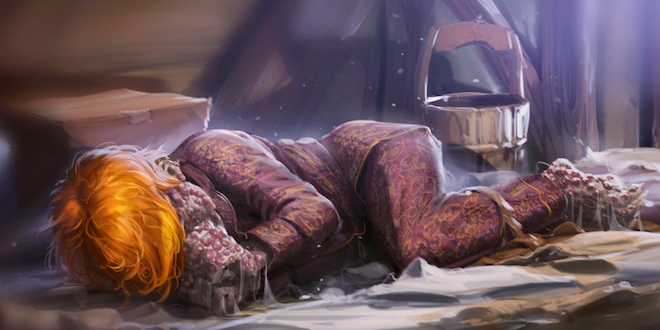What Would Muggle Doctors Say About Spattergroit?
by Nadine A. M. Abdalla
Arthur Weasley might wonder what Muggle doctors would tell him about magical maladies. We know that wizards can be affected by some illnesses that we, Muggles, can’t. Dragon pox and spattergroit are some examples. So with this in mind, what would actual Muggle doctors think about the most well-described magical disease?
We need to revisit the passage in Harry Potter and the Order of the Phoenix in which a medieval Healer tells Ron he has spattergroit. Here is what he says:
‘’Tis a most grievous affliction of the skin, young master, that will leave you pockmarked and more gruesome even than you are now -’
‘Watch who you’re calling gruesome!’ said Ron, his ears turning red.
‘The only remedy is to take the liver of a toad, bind it tight about your throat, stand naked by the full moon in a barrel of eels’ eyes -’
‘I have not got spattergroit!’
‘But the unsightly blemishes upon your visage, young master -’
‘They’re freckles!’ said Ron furiously. ‘Now get back in your own picture and leave me alone!’” (OotP 508)
We know that in the last novel, this exchange proves itself crucial. Ron, his father, and the twins devise a plan to transfigure their ghoul into Ron with spattergroit so that he can’t go to Hogwarts. Let’s see how the ghoul is when he is pretending to be Ron:
He was also sure that ghouls were generally rather slimy and bald, rather than distinctly hairy and covered in angry purple blisters.” (DH 98)
Ron later adds some interesting information about this affliction:
If anyone comes calling to investigate, Mum or Dad can show them the ghoul in my bed, covered in pustules. Spattergroit’s really contagious, so they’re not going to want to go near him. It won’t matter that he can’t say anything, either, because apparently you can’t once the fungus has spread to your uvula.” (DH 99)
We may ask ourselves which Muggle disease can also be confused with freckles. However, we need to understand what freckles are in the first place. A Muggle doctor would say that freckles are pigmented “macules” – flat lesions with a diameter of less than 0.5 cm.1 On the other hand, blisters and pustules (the skin lesions Harry and Ron say the “spattergroit-affected” ghoul has) aren’t flat lesions. A blister is “elevated” because it has fluid inside it; it also has a bigger diameter than a freckle.1 Pustules are a collection of pus and appear more in bacterial infections but can also appear in fungal ones like spattergroit.
Anyway, in Muggle medicine, there is a disease that may have freckles. Elevated lesions are also present, yet these lesions aren’t blisters or pustules – they are nodules (a lump >0.5 cm in diameter).1, 2 This affliction is called neurofibromatosis type 1.
Neurofibromatosis type 1 is a genetic condition. It may present as freckles in areas such as the groin, axillae, or neck base or even below the breasts. There are other skin signs, including café-au-lait spots (coffee-with-milk-colored patches) from the first year of life.2 Some cases may show “dermal neurofibromas” at puberty, which are “unsightly” violet-colored nodules somewhat like the ghoul’s violet blisters; patients may complain of itching, but they are painless. There are also “nodular neurofibromas” that arise from nerve trunks and are very firm.2
So what would Muggle doctors say about spattergroit? We can guess that they would be very intrigued. At first, they would analyze the lesions and wonder whether there are other symptoms, like itching (more common in fungal infections on the skin) or even fever (more common in bacterial infections). They could ask if the symptoms started in the first year of life (neurofibromatosis type 1, for example) and inquire about its transmission and evolution. All these questions a Muggle doctor could ask, yet medicine is complex and not so black and white: One sign doesn’t exclude the other. Nonetheless, you can be sure that they would never prescribe moon bathing in a barrel of eels’ eyes (OotP 508); however, depending on the case, they might “cut people up” (OotP 484) if the lesion needs excision like in neurofibromatosis type 1.2 Fungal skin infections in wizards can put them in quarantine more often than usual. Be that as it may, what about Muggle-borns? Are they twice more prone to illnesses because they are a part of both worlds? That’s something wizards should definitely research.
1Baldwin, Andrew. Oxford Handbook of Clinical Specialties (Oxford Medical
Handbooks). 11th ed., Oxford University Press, 2020.
2 Wilkinson, Ian B. et al. Oxford Handbook of Clinical Medicine. 10th ed., Oxford
University Press, 2017.


